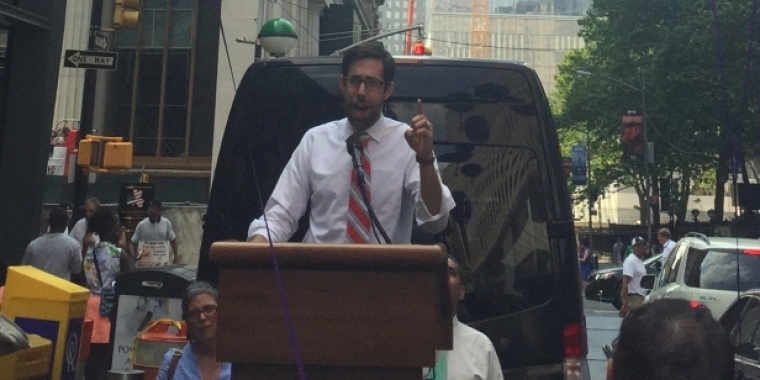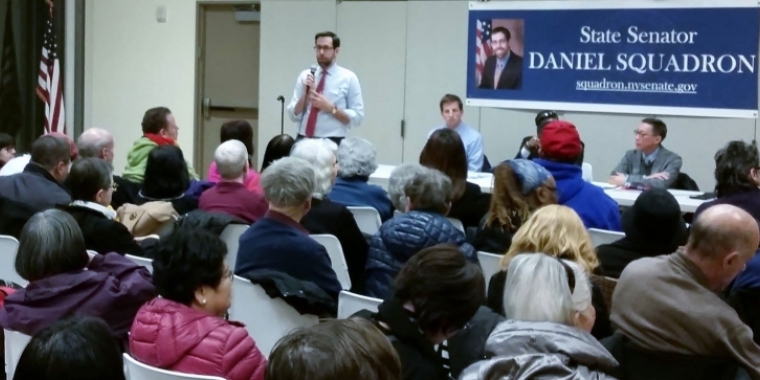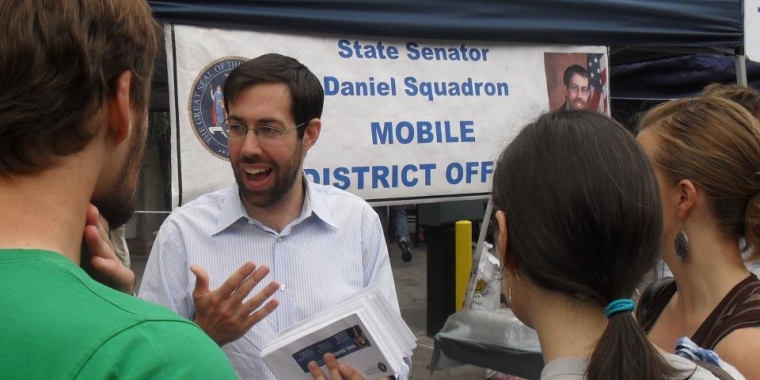
Sponsor's Memo for Commission on Governmental Ethics Act of 2009
Daniel L. Squadron
Click here to read and comment on the text of the bill
NEW YORK STATE SENATE
MEMORANDUM IN SUPPORT OF LEGISLATION
submitted in accordance with Senate Rule VI, Sec 1.
( x ) Memo on original draft bill
( ) Memo on amended bill
SENATE BILL #: ASSEMBLY BILL #:
SENATE SPONSOR (S): Squadron
ASSEMBLY SPONSOR (S):
TITLE OF BILL:
Commission on governmental ethics act of 2009.
PURPOSE OR GENERAL IDEA OF BILL:
Enact ethics reform by creating a commission on governmental ethics to cover both the legislative and executive branches of government.
SUMMARY OF PROVISIONS:
This bill merges the Legislative Ethics Commission (LEC) and the Commission on Public Integrity (CPI), combining the duties of both bodies within a new Commission on Governmental Ethics.
Section 1 establishes the commission on governmental ethics act of 2009.
Section 2 creates the Commission on Governmental Ethics, which covers both the executive and legislative branches. The Commission consists of nine members, three of whom are chosen by the governor and one each chosen upon the recommendation of the comptroller, attorney general, senate majority leader, senate minority leader, assembly speaker and assembly minority leader. Members of the Commission are not allowed to be state or federal lobbyists or employed by political consulting firms, or the recipient of a state contract. The Chair and Vice-Chair of the Commission are to be selected by a majority vote of the Commissioners, either the Chair or the Vice-Chair must be selected from among the appointees of the legislative branches, and the Chair and Vice-Chair must be members of different major political parties.
Section 3 states that the Chair and Vice-Chair jointly select the executive director of the Commission, and that the executive director shall be appointed without regard to political affiliation and solely on the basis of fitness to perform the assigned duties. The executive director serves a five-year term and cannot serve more than two consecutive terms.
Section 4 sets forth the procedures the Commission must take when it receives notification of a possible violation of certain provisions of the Public Officers Law, Civil Service Law or Legislative Law, and states that the Commission shall publicly disclose the outcome of the proceedings.
Section 5 repeals subdivision 13-a of section 94 of the executive law, which established the Commission on Public Integrity.
Section 6 sets forth the powers and duties of the Commission, which include the power and duty to promulgate rules concerning restrictions on outside activities and limitations on the receipt of gifts and honoraria by persons subject to its jurisdiction; the power to conduct investigations, hold hearings, administer oaths, affirmations, subpoena witnesses, compel their attendance, examine them under oath and require the production of books, records, documents or other evidence, and the duty to create a website.
Section 7 clarifies that the Commission continues to have jurisdiction over state officials who have left office or state service.
Section 8 makes technical changes.
Section 9 makes technical changes.
Section 10 states that the Commission’s activities shall be subject to oversight by the state legislature and requires the legislative committees responsible for oversight of the commission to hold hearings on the annual report and recommendations of the Commission within thirty days of its release.
Section 11 repeals Article 5 of the legislative law, which established the legislative Ethics commission and its activities.
Section 12 transfers responsibility for enforcement of Article 14 of the Election Law from the State Board of Elections to the Commission on Governmental Ethics.
Section 13 makes technical changes.
Section 14 provides that no Commissioner may be appointed as members to the board of the New York Racing Association, Inc.
Sections 15-17 transfers all powers, duties, functions, employees and records previously conferred upon the Commission on Public Integrity and the Legislative Ethics Commission to the Commission on Governmental Ethics.
Sections 18-23 make technical changes relating to the transfer of functions from the Commission on Public Integrity and the Legislative Ethics Commission to the Commission on Governmental Ethics.
Section 24 relates to the compilation by state agencies of information regarding persons who have business dealings with the state.
Section 25 requires the Commission to submit a report to the Governor and the Legislature on the status of the information required to be gathered as described in section 24.
Section 26 contains a separability clause.
Section 27 provides that the act shall take effect January 1, 2010.
JUSTIFICATION:
The ethics changes that were enacted in 2007 included several important reforms. However, the creation of the Commission on Public Integrity (which oversees the executive branch) and the Legislative Ethics Commission (overseeing the legislative branch) did not go far enough to ensure that an independent body oversee ethics with respect to the executive and legislative branches of government. The Commission on Governmental Ethics would essentially merge these two entities -- and contain appointees by both the executive and legislative branches -- in an effort to increase effectiveness, independence and transparency.
The Commission on Governmental Ethics, if established, would follow the national trend of state ethics commissions that oversee both the executive and legislative branches, in addition to overseeing lobbyists and candidates for public office, in certain circumstances. By its structure, it would be virtually impossible for the newly established commission to be dominated by any one individual, elected official, or branch of government.
PRIOR LEGISLATIVE HISTORY:
None.
FISCAL IMPLICATIONS:
The merger of these two entities should have no fiscal impact.
EFFECTIVE DATE:
January 1, 2010.
Share this Article or Press Release
Newsroom
Go to NewsroomState Senate Thanksgiving Creative Celebration Submissions
November 24, 2015



